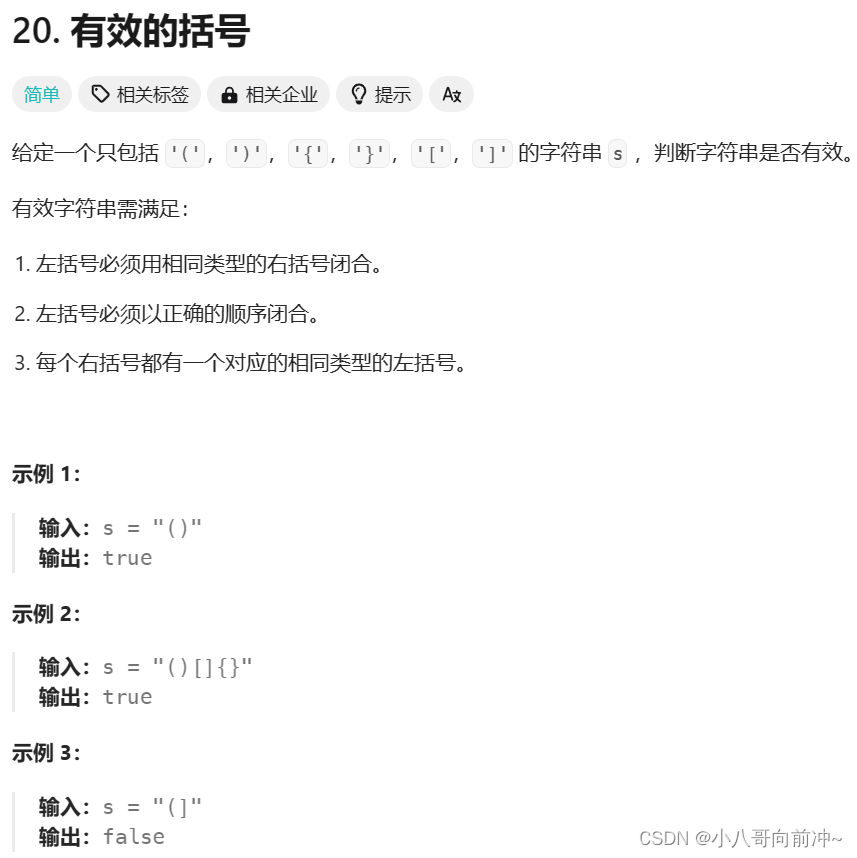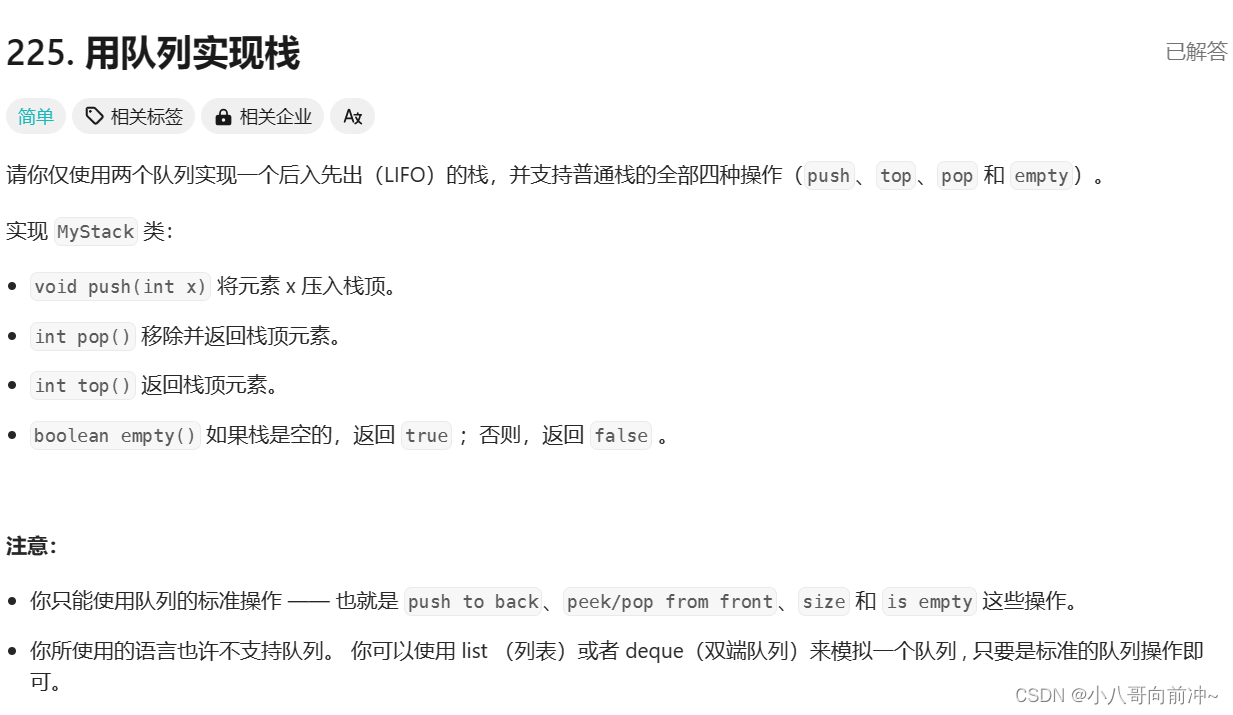【LeetCode】栈和队列oj专题
赞
踩
有不懂的地方一定要看看我往期文章哦!
所属专栏:数据结构【c语言】
注意:这些题目实现全部由c语言实现,解决这些问题需要用到栈和队列,如果对c语言实现栈和队列有问题的同学,可以看:队列的实现 和 栈的实现 俩篇文章哦!
目录
配括号问题
题目:

思路:
我们将 '(' '[' '{'统称为左括号,将 ']' ')' '}'统称为右括号。
经过观察,这个配括号问题就是一个简单的配对问题。
我们遍历数组,将左括号全部入栈,然后一一出栈和数组中右括号进行配对。
实现代码的时候需要注意几点:
- 如果数组里面没有左括号,只有右括号,则永远配不成功。
- 如果出栈配对时,栈里最终还有左括号,也就是说右括号比左括号多,也配不成功。
代码:
- typedef char STDateType;
- //栈
- typedef struct stack
- {
- STDateType* a;
- int top;
- int capacity;
- }ST;
-
- //栈的初始化和销毁
- void STInit(ST* p);
- void STDestroy(ST* p);
- //入栈,出栈
- void STpush(ST* p,STDateType x);
- void STpop(ST* p);
- //栈顶的数据
- STDateType STtop(ST* p);
- //栈的数据个数
- int STsize(ST* p);
- //判空
- bool STEmpty(ST* p);
- //栈的初始化和销毁
- void STInit(ST* p)
- {
- assert(p);
- p->a = NULL;
- p->capacity = 0;
- p->top = 0;
- }
- void STDestroy(ST* p)
- {
- assert(p);
- free(p->a);
- p->capacity = p->top = 0;
- }
- //入栈,出栈
- void STpush(ST* p, STDateType x)
- {
- assert(p);
- if (p->top == p->capacity)
- {
- int newcapacity = p->capacity == 0 ? 4 : p->capacity * 2;
- STDateType* tmp = (STDateType*)realloc(p->a, newcapacity * sizeof(STDateType));
- if (tmp == NULL)
- {
- perror("realloc failed!");
- return;
- }
- p->a = tmp;
- p->capacity = newcapacity;
- }
- p->a[p->top++] = x;
- }
- void STpop(ST* p)
- {
- assert(p);
- //出栈的话要判断一下空的情况
- assert(!STEmpty(p));
- p->top--;
- }
- //栈顶的数据
- STDateType STtop(ST* p)
- {
- assert(p);
- //出栈的话要判断一下空的情况
- assert(!STEmpty(p));
- return p->a[p->top-1];
- }
- //栈的数据个数
- int STsize(ST* p)
- {
- assert(p);
- return p->top;
- }
- //判空
- bool STEmpty(ST* p)
- {
- assert(p);
- return p->top == 0;
- }
- bool isValid(char* s) {
- ST st;
- STInit(&st);
- while(*s)
- {
- //左括号入栈
- if(*s=='('||*s=='['||*s=='{')
- {
- STpush(&st,*s);
- }
- else
- {
- //如果一个左括号也没有,栈里面就没有数据,那么永远配不成功
- if(STEmpty(&st))
- {
- STDestroy(&st);
- return false;
- }
- char top=STtop(&st);
- STpop(&st);
- if(top=='('&&*s!=')'
- ||top=='['&&*s!=']'
- ||top=='{'&&*s!='}')
- {
- STDestroy(&st);
- return false;
- }
- }
- s++;
- }
- //如果出栈配对后,栈里还有左括号,那么也永远配不成功
- bool ret=STEmpty(&st);
- STDestroy(&st);
- return ret;
- }

循环队列问题
题目:

思路:两种方法
方法一:
将这个循环队列看成循环数组。

由于队列的先进先出原则,我们可以定义三个变量:头变量,尾变量,数据个数变量。
我们简单推理知道:我们动态开辟k个数据,进队列,从尾插入数据,入队列,从头删除数据,出队列。
可是又有一个新的问题:如何判断这个循环数组里面是空还是满呢?
上图:

由此可知,我们判断不了满的情况和空的情况。
我们可以这样来解决:
- 定义一个size变量,记录数组数据个数。
- 多开辟一个数据空间。
我们主要介绍第二种解决方案。
那么如何判断空和满呢?

另外需要注意的是:
在入队列(tail++)时,tail可能会越界,也要取模运算,出队列(head++)时,head也可能越界,也要取模运算。
思路到了这里,还要最后一个问题:怎么访问尾队列数据和头队列数据呢?
我们访问头队列数据很容易,直接访问头变量就行,可是尾呢?
上图:

代码:
-
-
-
- typedef struct {
- int*a;
- int head;
- int tail;
- int k;
- } MyCircularQueue;
-
-
- MyCircularQueue* myCircularQueueCreate(int k) {
- MyCircularQueue*p=(MyCircularQueue*)malloc(sizeof(MyCircularQueue));
- //多开一个空间,解决判满判空冲突问题
- p->a=(int*)malloc(sizeof(int)*(k+1));
- p->head=p->tail=0;
- p->k=k;
- return p;
- }
- bool myCircularQueueIsEmpty(MyCircularQueue* obj) {
- return obj->head==obj->tail;
- }
-
- bool myCircularQueueIsFull(MyCircularQueue* obj) {
- return (obj->tail+1)%(obj->k+1)==obj->head;
- }
- bool myCircularQueueEnQueue(MyCircularQueue* obj, int value) {
- if(myCircularQueueIsFull(obj))
- {
- return false;
- }
- obj->a[obj->tail]=value;
- obj->tail++;
- (obj->tail)%=(obj->k+1);
- return true;
- }
-
- bool myCircularQueueDeQueue(MyCircularQueue* obj) {
- if(myCircularQueueIsEmpty(obj))
- {
- return false;
- }
- obj->head++;
- (obj->head)%=(obj->k+1);
- return true;
- }
-
- int myCircularQueueFront(MyCircularQueue* obj) {
- if(myCircularQueueIsEmpty(obj))
- {
- return -1;
- }
- else
- return obj->a[obj->head];
- }
-
- int myCircularQueueRear(MyCircularQueue* obj) {
- if(myCircularQueueIsEmpty(obj))
- {
- return -1;
- }
- else
- return obj->a[(obj->tail+obj->k)%(obj->k+1)];
- //return obj->a[obj->tail==0?k:obj->tail-1];
- }
-
- void myCircularQueueFree(MyCircularQueue* obj) {
- free(obj->a);
- free(obj);
- }
-

方法二
思路:
我们可以将这个循环队列看成循环链表。
定义三个指针变量:尾指针,头指针,尾指针的前一个指针。
进队列,从尾进,尾指针指向下一个,出队列,从头出,头指针指向下一个。
有了上一部分基础,我们判空判满依旧可以多开辟一个空间。
为什么要定义尾指针的前一个指针,只定义头指针和尾指针不行吗?
当我们访问尾队列数据时,可以直接用尾指针的前一个指针直接访问就行,省了一个循环找尾队列数据的遍历!
代码:
- typedef struct Node
- {
- struct Node*next;
- int val;
- }Node;
-
- typedef struct {
- Node*phead;
- Node*ptail;
- Node*preptail;
- } MyCircularQueue;
-
-
- MyCircularQueue* myCircularQueueCreate(int k) {
- MyCircularQueue*obj=(MyCircularQueue*)malloc(sizeof(MyCircularQueue));
- obj->phead=obj->ptail=NULL;
- for(int i=0;i<k+1;i++)
- {
- Node*cur=(Node*)malloc(sizeof(Node));
- cur->next=NULL;
- if(obj->phead==NULL)
- {
- obj->phead=obj->ptail=cur;
- }
- else
- {
- obj->ptail->next=cur;
- obj->ptail=cur;
- }
- }
- obj->ptail->next=obj->phead;
- obj->preptail=obj->ptail;
- obj->ptail=obj->phead;
- return obj;
- }
- bool myCircularQueueIsEmpty(MyCircularQueue* obj) {
- return obj->phead==obj->ptail;
- }
-
- bool myCircularQueueIsFull(MyCircularQueue* obj) {
- return obj->ptail->next==obj->phead;
- }
-
- bool myCircularQueueEnQueue(MyCircularQueue* obj, int value) {
- if(myCircularQueueIsFull(obj))
- {
- return false;
- }
- obj->ptail->val=value;
- obj->ptail=obj->ptail->next;
- obj->preptail=obj->preptail->next;
- return true;
- }
-
- bool myCircularQueueDeQueue(MyCircularQueue* obj) {
- if(myCircularQueueIsEmpty(obj))
- {
- return false;
- }
- obj->phead=obj->phead->next;
- return true;
- }
-
- int myCircularQueueFront(MyCircularQueue* obj) {
- if(myCircularQueueIsEmpty(obj))
- {
- return -1;
- }
- return obj->phead->val;
- }
-
- int myCircularQueueRear(MyCircularQueue* obj) {
- if(myCircularQueueIsEmpty(obj))
- {
- return -1;
- }
- return obj->preptail->val;
- }
-
- void myCircularQueueFree(MyCircularQueue* obj) {
- while(obj->phead!=obj->ptail)
- {
- Node*next=obj->phead->next;
- free(obj->phead);
- obj->phead=next;
- }
- free(obj);
- }

用栈实现队列
题目:

思路:
我们可以将一个栈专门用来入数据的,另一个专门用来出数据的。
当出数据的栈为空时,还想出数据,将入数据的栈的数据全部导入出数据的栈,再继续出数据即可!
代码:
- typedef int STDateType;
- //栈
- typedef struct stack
- {
- STDateType* a;
- int top;
- int capacity;
- }ST;
-
- //栈的初始化和销毁
- void STInit(ST* p);
- void STDestroy(ST* p);
- //入栈,出栈
- void STpush(ST* p,STDateType x);
- void STpop(ST* p);
- //栈顶的数据
- STDateType STtop(ST* p);
- //栈的数据个数
- int STsize(ST* p);
- //判空
- bool STEmpty(ST* p);
-
-
- //栈的初始化和销毁
- void STInit(ST* p)
- {
- assert(p);
- p->a = NULL;
- p->capacity = 0;
- p->top = 0;
- }
- void STDestroy(ST* p)
- {
- assert(p);
- free(p->a);
- p->capacity = p->top = 0;
- }
- //入栈,出栈
- void STpush(ST* p, STDateType x)
- {
- assert(p);
- if (p->top == p->capacity)
- {
- int newcapacity = p->capacity == 0 ? 4 : p->capacity * 2;
- STDateType* tmp = (STDateType*)realloc(p->a, newcapacity * sizeof(STDateType));
- if (tmp == NULL)
- {
- perror("realloc failed!");
- return;
- }
- p->a = tmp;
- p->capacity = newcapacity;
- }
- p->a[p->top++] = x;
- }
- void STpop(ST* p)
- {
- assert(p);
- //出栈的话要判断一下空的情况
- assert(!STEmpty(p));
- p->top--;
- }
- //栈顶的数据
- STDateType STtop(ST* p)
- {
- assert(p);
- //出栈的话要判断一下空的情况
- assert(!STEmpty(p));
- return p->a[p->top-1];
- }
- //栈的数据个数
- int STsize(ST* p)
- {
- assert(p);
- return p->top;
- }
- //判空
- bool STEmpty(ST* p)
- {
- assert(p);
- return p->top == 0;
- }
-
-
- typedef struct {
- ST pushst;
- ST popst;
- } MyQueue;
-
-
- MyQueue* myQueueCreate() {
- MyQueue*p=(MyQueue*)malloc(sizeof(MyQueue));
- STInit(&(p->pushst));
- STInit(&(p->popst));
- return p;
- }
-
- void myQueuePush(MyQueue* obj, int x) {
- STpush(&(obj->pushst),x);
- }
-
- int myQueuePop(MyQueue* obj) {
- int top=myQueuePeek(obj);
- STpop(&(obj->popst));
- return top;
- }
-
- int myQueuePeek(MyQueue* obj) {
- if(STEmpty(&(obj->popst)))
- {
- while(!STEmpty(&(obj->pushst)))
- {
- STpush(&(obj->popst),STtop(&(obj->pushst)));
- STpop(&(obj->pushst));
- }
- }
- return STtop(&(obj->popst));
- }
-
- bool myQueueEmpty(MyQueue* obj) {
- return STEmpty(&(obj->pushst))&&STEmpty(&(obj->popst));
- }
-
- void myQueueFree(MyQueue* obj) {
- STDestroy(&(obj->pushst));
- STDestroy(&(obj->popst));
- free(obj);
- }

用队列实现栈
题目:

思路:
我们可以将判断俩队列哪个为空队列,哪个不为空队列。
进栈时,入数据在不为空的队列里,出栈时,出数据时,需要将不为空队列的数据导入为空队列中去,然后再去出栈!
而判断哪个为空队列,我们可以用假设法!
代码:
- typedef int QDataType;
- //原则:先进先出
-
- //队列
- typedef struct QueueNode
- {
- struct QueueNode* next;
- QDataType val;
- }QNode;
-
- //管理队列的一些参数
- typedef struct Queue
- {
- QNode* phead;
- QNode* ptail;
- int size;//队列中数据的个数
- }Queue;
-
- //参数初始化
- void QueueInit(Queue* pq);
- //入队 队尾入队
- void Queuepush(Queue* pq, QDataType x);
- //出队 队头出队
- void Queuepop(Queue* pq);
- //数据个数
- int Queuesize(Queue* pq);
- //队列判空
- bool QueueEmpty(Queue* pq);
- //队尾数据
- QDataType QueueBack(Queue* pq);
- //队头数据
- QDataType QueueFront(Queue* pq);
- //队列的销毁
- void QueueDestroy(Queue* pq);
-
- //参数初始化
- void QueueInit(Queue* pq)
- {
- assert(pq);
- pq->phead = pq->ptail = NULL;
- pq->size = 0;
- }
- //入队 队尾入队
- void Queuepush(Queue* pq, QDataType x)
- {
- QNode* node = (QNode*)malloc(sizeof(QNode));
- if (node == NULL)
- {
- perror("malloc failed!");
- return;
- }
- node->next = NULL;
- node->val = x;
- //入队
- if (pq->ptail == NULL)
- {
- pq->phead = pq->ptail = node;
- }
- else
- {
- pq->ptail->next = node;
- pq->ptail = node;
- }
- //插入数据,数据个数增加
- pq->size++;
- }
-
- //出队 队头出队
- void Queuepop(Queue* pq)
- {
- assert(pq);
- //队列不能为空
- assert(pq->size > 0);
- //当只有一个节点时,出队后,尾指针变成野指针!
- if (pq->phead->next == NULL)//一个节点
- {
- free(pq->phead);
- pq->phead = pq->ptail = NULL;
- }
- else//多个节点
- {
- QNode* next = pq->phead->next;
- free(pq->phead);
- pq->phead = next;
- }
- pq->size--;
- }
- //队尾数据
- QDataType QueueBack(Queue* pq)
- {
- assert(pq->size > 0);
- return pq->ptail->val;
- }
- //队头数据
- QDataType QueueFront(Queue* pq)
- {
- assert(pq->size != 0);
- return pq->phead->val;
- }
-
- //数据个数
- int Queuesize(Queue* pq)
- {
- assert(pq);
- return pq->size;
- }
- //队列判空
- bool QueueEmpty(Queue* pq)
- {
- assert(pq);
- return pq->size == 0;
- }
- //队列的销毁
- void QueueDestroy(Queue* pq)
- {
- assert(pq);
- QNode* cur = pq->phead;
- while (cur)
- {
- QNode* next = cur->next;
- free(cur);
- cur = next;
- }
- pq->phead = pq->ptail = NULL;
- pq->size = 0;
- cur = NULL;
- }
-
- typedef struct {
- Queue q1;
- Queue q2;
- } MyStack;
-
-
- MyStack* myStackCreate() {
- MyStack*p=(MyStack*)malloc(sizeof(MyStack));
- QueueInit(&(p->q1));
- QueueInit(&(p->q2));
- return p;
- }
-
- void myStackPush(MyStack* obj, int x) {
- if(!QueueEmpty(&(obj->q1)))
- {
- Queuepush(&(obj->q1),x);
- }
- else
- {
- Queuepush(&(obj->q2),x);
- }
- }
-
- int myStackPop(MyStack* obj) {
- Queue*empty=&(obj->q1);
- Queue*noempty=&(obj->q2);
- if(!QueueEmpty(&(obj->q1)))
- {
- noempty=&(obj->q1);
- empty=&(obj->q2);
- }
- while(Queuesize(noempty)>1)
- {
- Queuepush(empty,QueueFront(noempty));
- Queuepop(noempty);
- }
- int front=QueueFront(noempty);
- Queuepop(noempty);
- return front;
- }
-
- int myStackTop(MyStack* obj) {
- if(!QueueEmpty(&(obj->q1)))
- {
- return QueueBack(&(obj->q1));
- }
- else
- {
- return QueueBack(&(obj->q2));
- }
- }
-
- bool myStackEmpty(MyStack* obj) {
- return QueueEmpty(&(obj->q1))&&QueueEmpty(&(obj->q2));
- }
-
- void myStackFree(MyStack* obj) {
- QueueDestroy(&(obj->q1));
- QueueDestroy(&(obj->q2));
- free(obj);
- }

这些题目你都掌握了吗?只要对链表和顺序表很熟悉,解决这种题目还是很轻松的!
我们下期见!



